Ted Bohus: The Deadly Interview – Part 2
For those readers tuning in late, this is the second part of a two part interview started in last week’s column. http://www.crazedfanboy.com/npcr09/retropcr482.php
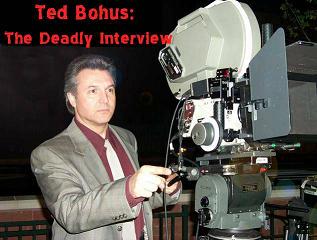 ET: When you came up with story for The Deadly Spawn were you already being conscious of the budget and keeping it bound to just the one house?
ET: When you came up with story for The Deadly Spawn were you already being conscious of the budget and keeping it bound to just the one house?
TB: Yes, that’s all we could do. We did have the vegetarian luncheon scene in a different house. That was shot at my house. Originally I had wanted scenes to show why they were trapped in the house. Every time they opened a door there was a creature there. There were originally supposed to be different types of spawns too. We were going to have spider spawns and scorpion spawns, all kinds of mutations. I wanted to do a transformation scene which would show a spawn going from the tadpole stage to the stage where the arms are poking out. We tried to show it in the film with a little spawn getting paint on it and as it gets bigger and bigger it still has the paint on it. No one noticed it, it didn’t work to well. The first version of the story I had was way too crazy, I had to keep scaling it back and scaling it back. At one point, by the end of the film, I was sitting out on the stoop and Tim Hildebrandt came and sat next to me. He asked what was the matter and I told him the ending of the movie was not the ending I wanted. Originally at the end we were going to have the kid outside and he sees a meteor come down and another one and another one. It was supposed to insinuate that their might be spawns in all these meteors – we were having a meteor shower of these spawn things. That wasn’t the ending I wanted but that was the ending we could do. He asked me what I wanted for the ending and I told him the ending, like you see in the movie, where a big spawn bursts out of the mountain and dwarfs the houses. He said “I’ll do the ending for you. I’ll take care of the whole thing.” He did too, he built that whole set, he had other people helping him with the houses and stuff but he supervised the whole thing.
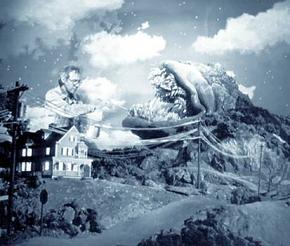
Tim Hidebrandt works on the "big" finale for Deadly Spawn.
ET: It worked very well because it bookends with the shot of the house at the beginning of the film when everything is peaceful. How many spawns, from the small ones up to the big one were created for the film?
TB: Oh, I don’t know. There had to be at least twenty or thirty of them.
ET: There are probably at least that many in the scene you mentioned of the vegetarian luncheon. There are different types too including some that look like stumps at the bottom of the couch.
TB: (laughs) That scene was in my house and we couldn’t get blood on anything. We made blood out of rubber and we put spots of it on the couch. Any time you saw a spawn move or its mouth open and close that had to be operated from somewhere. When you saw them moving on the floor, we luckily had a piece of carpet that my parent’s had in the house at the time. We were able to put of piece of wood under it with a slot to guide the spawn and a puppeteer to move it. There were all kinds of spawns in that scene. We wanted to show as many as we possibly could – as many as we could afford to show. John Dods was an animator. He did the Grog films. He did a lot of stop motion animation, beautiful stuff. I thought we were going to have a lot of stop motion in Deadly Spawn. Then he called me up one day and said come over and take a look at this stuff. I went over and he had he had the spawns that zipped along the water and they zipped up the walls. All he did was cut tracts in the wood and he put a plastic card in the spawn and put it in the tract and pulled it with a string. They looked like they were swimming around in the water – we didn’t even need stop motion. He came up with a great idea.
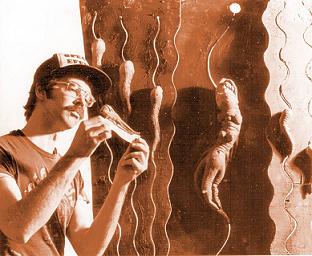
John Dods designs the ambulatory creatures.
ET: So whatever happened to these twenty or thirty prop spawns?
TB: I loaned the big spawn out for another film Fred Olen Ray did, I think it was Star Slammer. I forget because it probably had two or three different names. I shipped it out to them and it was used in some kind of scene with a fight in a prison. The thing just eventually fell apart. It was made of rubber and you have to realize this thing was in existence since 1980. Most of the smaller props were rubber too and they just disintegrated. I know we gave one of the two foot spawns to Forry Ackerman. I had a couple of teeth from the big spawn but somebody at a convention offered me a lot of money so I had to sell them. I still kept one, so I have one blood stained big tooth from The Deadly Spawn!
ET: Weren’t there some promotions for the theatrical release where you had the big spawn in the movie theaters on display?
TB: Yes, we brought the spawn to one of the theaters and stuck it in the corner. By that time it had compressed down so it wasn’t the impressive seven feet it should have been. It was more like four feet tall. In 1979 or 1980, we didn’t know any of the techniques for doing this stuff. We were using rubber cement for drool. We were using dental material for the teeth that was very heavy. The first heads that John made were on wooden braces because they kept breaking. He had to make metal armatures to go under the spawn because all that stuff was so heavy. This thing was a monster – literally! Eventually it just crushed down on itself.
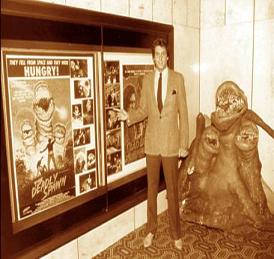 ET: You wrapped filming in 1981, how long were you in post production?
ET: You wrapped filming in 1981, how long were you in post production?
TB: We started post production around the end of ’81, beginning of ’82. It may have been more than a year. Marc Harwood was the editor on the film and is one of my good friends to this day. We were lucky to have him. After we finished the film, I shopped it around for a distributor. There were a lot of companies that were interested in the film right off the bat. I was getting all of these small companies that were interested so I thought I would take the film up to Paramount, who was located in New York at the time. I took the film to Paramount and they wanted me to leave the 16mm print there. It was the only one I had so I begged them to be careful with it. The secretary and the guys in the office were all big film fans so we did a lot of talking, it was great. They looked at the film and called me back and said they might be interested. It was going up a step to another group that was coming in and they would look at it. Now I was really excited. They called back again and said it had passed the next level, now they have to send the film out to California. If it passes that level, then they can make me an official offer for distribution. I said “You have got to be kidding me!” I bought gifts for everyone in that office. Then I got the horrifying phone call, the guy says “Ted, I feel just awful but the word came back from California that the film is a little too rough for Paramount’s standards and we have to pass.” I never expected it to be released by Paramount but, all of a sudden, once it starts happening you get into that possibility. What a horror that was, when you get into thinking that it really might happen it takes the wind out of you when it doesn’t.
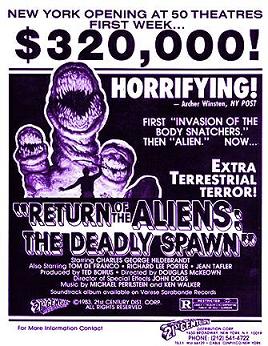 ET: Let’s talk about the film’s distribution. I know you had some problems with 21st Century Distribution Corporation who released it theatrically.
ET: Let’s talk about the film’s distribution. I know you had some problems with 21st Century Distribution Corporation who released it theatrically.
TB: Yes, we did. You have to remember that the film had a budget of twenty grand; I use that as a round figure, so how could you lose money? Our first check that came in, our advance, was fifty grand so we more than doubled our money the first check. It wasn’t until we were supposed to get the second check for fifty grand that we started to have problems. We got into some creative bookkeeping and, once again, I got very lucky. I met a disgruntled employee coming out of 21st Century one day, a guy I recognized from the office. He had an arm load of papers and stuff. I stopped him on the way out and introduced myself and we sat down and had a cup of coffee. He gave me an eye opening lesson on how distribution worked. He said “You want to know why you aren’t getting any money? Let me tell you why you aren’t getting any money, kid.” He told me that, for example, they send out twenty prints of a film to Texas to play in an area there. Let’s say they make one hundred thousand dollars for that week. They get all the newspapers in that town that they have deals with to run ads. If the ads cost one hundred dollars, they give them a receipt for one thousand dollars. They would do this for everything, storage, shipping, and television commercials – when the bills came in they were padded. They would make a hundred thousand dollars and when I asked how much of that I got they said I owed them twenty grand! It supposedly cost them a hundred and twenty thousand to do all this but that was BS. When they tried to do this with the lab, I told them I knew a guy who owned a lab and he would make the prints for me for four hundred dollars a piece. They acted like they thought that was great and then I got a bill for seventy five or eighty thousand dollars in lab costs. They took it to their own guy who charged fifteen hundred a print, of course they were really only paying four hundred and the rest went in their pocket. This guy gave me a real eye opening look into how they cheat and cook the books. We sued them but all we ended up getting was the rights to the film back and a crap load of worthless stock in 21st Century!
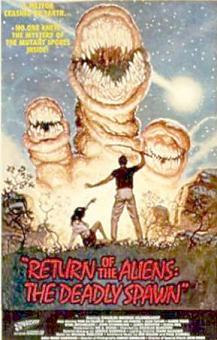 ET: Wasn’t it their idea to change the title to Return of the Aliens: The Deadly Spawn?
ET: Wasn’t it their idea to change the title to Return of the Aliens: The Deadly Spawn?
TB: Yes, they did that. They thought there was going to be a sequel to Alien so they decided they would change the title to grab onto that. They re-released it with that title, which I hated. I told them that but it was in the contract that they could change the title if they wanted to. I didn’t have final approval over the second release if they deemed it needed a title change.
ET: So the film was originally released as The Deadly Spawn and then re-released with Return of the Aliens added to the title? They didn’t change the title on the prints did they?
TB: No, I don’t really remember there may have been some. On the poster they put a sticker over the original Tim Hildebrandt artwork. They just slapped a sticker on it that said Return of the Aliens: The Deadly Spawn in block letters. You couldn’t get those damn stickers off for anything! We had a lot of trouble with the TV commercials. They made up a commercial and never bothered to have it pre-approved. They sent it out to stations and they said they couldn’t show it because it was too gory. They took it back and cut it but the stations said it was still too gory. By the time the film was ready to come out, they had cut all of the gore out of it. The theatrical trailer is good, I told them I wanted the guy who does the voiceovers for all the big movies trailers for it and they got him. The TV trailers were awful; they had cut out all the gore so there was nothing left but people running around. They did a good enough job with the promotions for what it was. It was a little film so no one was going to sink tons of dough into promotions.
ET: So what was next after Deadly Spawn?
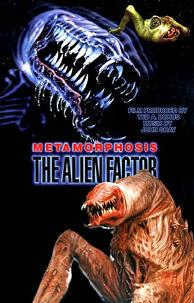 TB: I worked on a couple of other films and then started Metamorphosis: The Alien Factor in 1987, I believe. That was finished by 1988 and the main release was from Tri-Mark in 1989. The film was originally titled Deadly Spawn II and we had a million dollar budget. I would put the last half hour of Metamorphosis against just about any monster film out there. We had everything it that. We had prosthetics, we had animatronics, we had an eight foot animatronic creature, we had stop motion animation, and miniatures. We had everything and we had it all for a million bucks! In Metamorphosis, they had a piece of a creature, it was supposed to be the spawn, and they introduce it into different species. They create these mutations that all end up being these toothy sorts of spawn-like creatures.
TB: I worked on a couple of other films and then started Metamorphosis: The Alien Factor in 1987, I believe. That was finished by 1988 and the main release was from Tri-Mark in 1989. The film was originally titled Deadly Spawn II and we had a million dollar budget. I would put the last half hour of Metamorphosis against just about any monster film out there. We had everything it that. We had prosthetics, we had animatronics, we had an eight foot animatronic creature, we had stop motion animation, and miniatures. We had everything and we had it all for a million bucks! In Metamorphosis, they had a piece of a creature, it was supposed to be the spawn, and they introduce it into different species. They create these mutations that all end up being these toothy sorts of spawn-like creatures.
ET: So you got to revisit your idea of the different types of spawns?
TB: Exactly, we got to do some creatures that were what the spawn would look like if it mutated. First we called it Deadly Spawn II, and then we called it Deadly Spawn II: The Transformation. The investors didn’t really want a film that cost a million dollars to be tied to another one that was done for twenty thousand, so in the end we called it Metamorphosis. When we went to the film market in LA, there was another film called Metamorphosis, I think it was an Italian film. We decided to stick The Alien Factor on to ours to make it different. I had a hard time on Metamorphosis because I made the mistake of having partners and it was just a battle all the way through. It was a bad experience for me so I decided, rather than do these films where I have to have a big crew and be responsible to this and that, I would raise all the money, write, and direct it myself. I went back down to having a budget of like seventy five grand for my next picture, Regenerated Man, but at least I had control over the thing. I had film companies that were having a bidding war over that film. Finally, I told one company, Schanachie, let me sell Regenerated Man to another company and I will let you pick out one of the scripts I have and I will do that movie for you for the same amount. They picked out Vampire Vixens from Venus. At the time, that was a very clever title. Then all these crappy films came out with titles likeTest Tube Teens from the Year 2000. It was a bunch of films that all had these tricky names to them and they all sucked! There were no real monsters, no aliens, it was girls jumping around naked and that was it. At least mine had some aliens in it and some stuff besides the girls. I wanted to change the title to Vampire Invaders or something like that but they loved the original title. I told them I had done research on the market and we needed to change it and they just said no. Sure enough, a lot of companies that were planning to buy the film canceled their orders because they saw that a bunch of movies with titles like that were crappy and weren’t doing any business. They don’t watch these movies first; they just buy them out of a catalog and the market research for films with titles like that was bad.
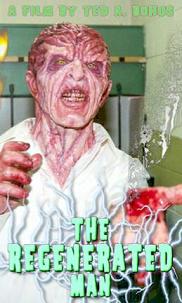 ET: There appears to be almost a ten year lag between this film and your next credit.
ET: There appears to be almost a ten year lag between this film and your next credit.
TB: I had people asking me to do a lot of films at the time but I wasn’t taking credit sometimes. I would let other people have the credit because I didn’t want to be known as a writer or a creature designer, that wasn’t my thing. There were a lot of things. I was doing script doctoring. People in Japan would send me scripts that they wanted Americanized and I would work on that for them. A lot of times I would tell them this was very similar to a script I already had and I would just sell them my script. After that I did a mob film, This Thing of Ours, with James Caan, Frank Vincent and Vincent Pastore. Then I did a musical called Destination Fame with Cuba Gooding, A.J. Gil, and Ricky Aiello. That’s coming out next month. After doing bigger budget films again, I still had problems with partners. I don’t remember how it came up exactly but I got together with a lot of friends and they wanted to make a movie. Everyone kicked in a little bit of money and we made Hell on Earth. It’s a simple plot. A bunch of people are in a house and it gets magically sealed off. A portal to another dimension is opened and all these zombies come through. They have to fight these monsters to get out of the house. It’s a very cheap film, probably as low a budget as Deadly Spawn but everyone got into it. We had a lot of fun and we are looking for a distributor now.
ET: That brings us full circle now to some new developments with Deadly Spawn.
TB: Yes, myself and Anthony Rojero are working on a comic strip of Deadly Spawn. The company that is doing it might put out a prequel that will hopefully turn into a movie. They are doing these package deals now where you come out with a comic and the movie deal is already there just in case. They want to do that and then a remake of Deadly Spawn and a sequel. I am also in talks for a new DVD release of the film with new extras. Some of the foreign DVD releases have some different features on them, like news clips, and we may use some of those. It may be on Blu-Ray but we will find something cool to do for it. There will be an extensive picture section with all you could ever want to see.
ET: Ted that was a great interview and I really appreciate your time. This was supposed to be a Deadly Spawn-centric interview and I think we accomplished that admirably.
TB: Yes, we did a good job. It was my pleasure.
For anyone interested in learning more about The Deadly Spawn or purchasing a copy of any of Ted’s films, I highly recommend his website http://www.deadlyspawn.net. Also, be on the look out for the forth coming release of his latest film, Hell on Earth, Ted’s low budget return to his horror film roots. Check the website for details.
